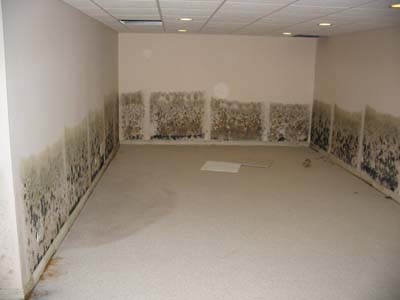Mold remediation (removal) -- What you need to know
(If you don't see growth and you're not sure if you have mold, see Mold Inspection.)Does your basement look like this?
 |
Most recognized authorities on the subject consider the threshold of the need for professionals to be around 10 square feet, but every situation is unique. Simply ripping out damaged materials yourself, or having an untrained person do it, could result in excessive amounts of airborne spores and microbes that can affect occupants of a house or building, and contaminate previously unaffected areas.
Professional remediation of mold entails three things:
- Safe removal of damaged materials that can't be cleaned or salvaged,
- Encapsulation (permanently covering and sealing) of damaged materials that can't (easily) be removed, and
- Cleaning of materials that can or must be salvaged
- There is a large area of damage
- Occupants of the building are very old, very young, or immunocompromised
- Occupants of the building are susceptible to allergies, asthma, etc.
- Proper action needs to be documented for legal or medical reasons
Beware of remediators who don't use third party verification.
Recognized authorities in the mold arena, such as the US Environmental Protection Agency (EPA), the American Conference of Governmental Industrial Hygienists (ACGIH), the American Industrial Hygiene Association (AIHA), all recommend third party oversight on mold remediation projects. As or January 2016, third party oversight is required by New York State law. This means having a consultant who doesn't work for the remediation company provide verification that the cleanup is done safely and properly. If you hire a company that verifies its own work, you have no way of knowing whether the work is being done correctly and safely. The removal process can send airborne mold spores into uncontaminated areas of the building, causing complaints, allergies, or new growth in a previously unaffected area.Three levels of third party verification are available:
- Baseline and post-remediation verification testing - Air samples as well as visual inspection done by the third party before and after remediation are used to verify that remediation work has been performed sufficiently and other parts of the building have remained uncontaminated. All work is professionally documented.
- Protocol development - A written protocol (instructions for cleanup procedures) is provided by the third party for the remediation team to follow.
- Oversight of cleanup - A third party consultant oversees the actual cleanup to verify that the protocol is being followed.
If your cleanup cost is being covered by insurance, they will likely cover the third party verification as well, but you must check with them. Also, as with any claim, the insurance carrier must be notified as soon as the problem occurs, as they are less likely to honor a claim if you tell them about it three weeks after the fact.
Be sure your third party consultant has an IAQ credential, such as a Certified Indoor Environmentalist.
Be sure your IAQ consultant uses an EMLAP (Environmental Microbial Laboratory Accreditation Program) certified lab.
How we can help you
- We can help to diagnose the cause of the damages, if needed, by using testing instruments, such as a moisture meter, infrared camera, and thermohygrometer.
- We provide a written report of recommendations of how problems like this can be avoided in the future.
- As a New York State-licensed mold assessor, we can take baseline samples prior to remediation with which to compare post-cleanup samples to make sure that your space has been cleaned safely and contamination has not spread to other areas of your house or building.
- We can write an industry standard protocol for cleanup that the remediator should follow.
- We provide third party verification that remediation has been done properly. Our only agenda is to make sure that your building is cleaned up thoroughly and safety. The best thing to do is to allow us to evaluate your property prior to remediation.

